When and how to harvest spring garlic?
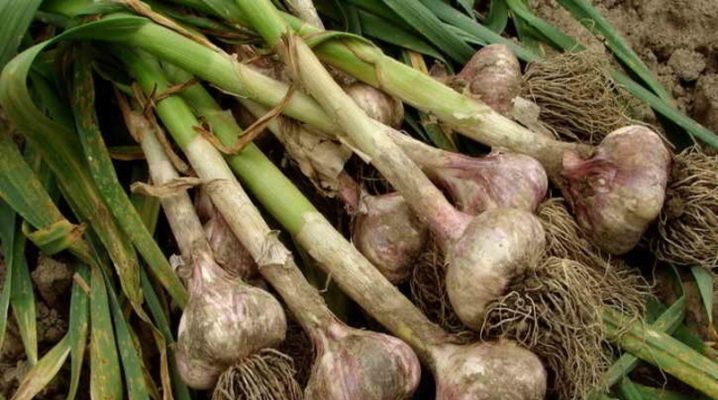
Spring garlic ripens later than winter garlic. The timing of harvesting depends on the variety of the vegetable itself, as well as on the region of cultivation. In order to dig the heads out of the ground in a timely manner, it is recommended that you familiarize yourself with when and how to harvest spring garlic.

Ripening signs
In order for spring garlic to be stored as long as possible, it is necessary to remove it in a timely manner. There are several ways to determine the degree of maturity.
- The arrows drop to the ground. They do not curl or straighten.
- No new arrows are formed.
- At the base, the stem turns yellow and dry.
These are all visual signs of external maturation. But, if this is not enough, you can dig out one head and carry out an additional check. Ripe garlic has the following characteristics:
- the lobules are well detached from each other;
- the husk is dry, when peeled, it emits a specific crunch;
- the teeth are formed and correspond to the dimensions of the given variety.
It should be borne in mind that the crop from the beds located on the south side is harvested about 10-12 days earlier than from those on the north side of the site.
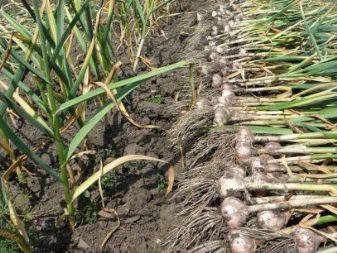
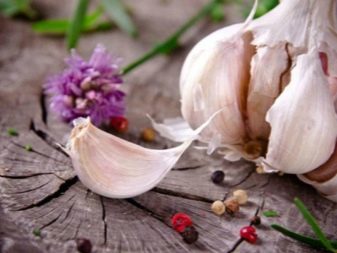
If the garlic meets all of the above indicated signs, then it is completely ready for harvesting.... In case of insufficient maturation, it is recommended to wait a few more days and then re-check. If the vegetable is ripe, you can dig it out.
Cleaning time
As already mentioned, the timing of harvesting directly depends on the region of cultivation. So, in the southern regions, spring garlic begins to be harvested at the end of June or early July. In the middle lane, for example, in the Moscow region, garlic planted in spring is harvested at the end of July. In some cases, the end of harvesting is delayed until the beginning of August.
In the Urals, Siberia, as well as the northern regions, the harvesting of summer garlic begins only at the end of August. This is due to the later landing. Sometimes, depending on weather conditions, such a vegetable is harvested only in September.
In order to determine the timing of harvesting, you need to know the following: it takes about 100 days for garlic to fully ripen. It is necessary to count from the date of planting, and then focus on weather conditions, as well as on external signs of ripening.

In order for the harvest to be of high quality, to be stored for a long time and to have the best taste, many summer residents are guided by the lunar calendar. There are favorable dates for harvesting garlic every year. For example, in 2021, the following are considered favorable:
- in July - from 5 to 7, 15, 16, 25, 26 and 27.
- in August - from 1 to 3, 12, 15, 29 and 30.
In July, it is undesirable to clean in the period from 1 to 4, and in August from 17 to 28. It is noteworthy that these days refer exclusively to 2021. In 2022, it is necessary to focus on the corresponding lunar calendar.
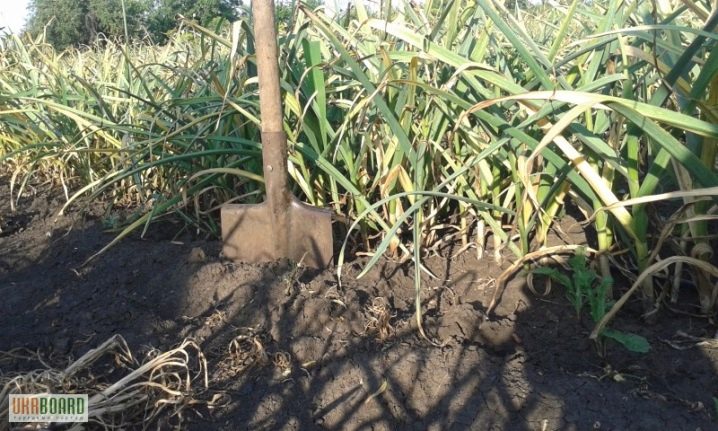
How to dig it right?
In order for the garlic to be stored for a long time, it is recommended to dig it out, following certain rules. They consist of several points.
- It is recommended to dig garlic from dry soil. If it rained the day before, it is better to postpone the harvest. Of course, you need to stop watering 5-7 days before the intended harvesting.
- Novice gardeners mistakenly use a shovel as the main tool for harvesting garlic. This is not correct, as it is recommended to use a pitchfork for this purpose. This is confirmed by several facts: the forks additionally loosen the soil, do not damage the vegetables.
- If for some reason it is not possible to use the pitchfork, then care must be taken when digging with a shovel... The process consists in digging up the ground, and already pulling the heads themselves out with your hands.
- In the process of harvesting the heads of garlic, it is most convenient to put them in buckets.
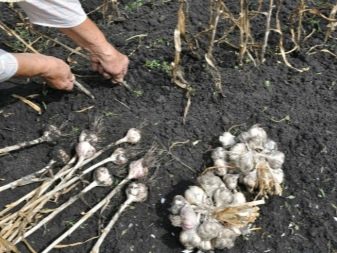
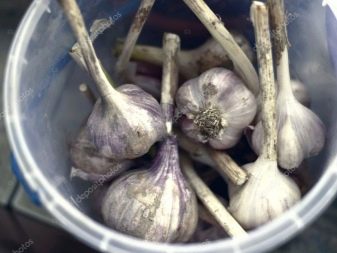
After the entire crop has been harvested, it must be sorted into two piles: damaged and undamaged. Garlic from the last group should be additionally sorted out: discard the rotten cloves, and eat the damaged ones as soon as possible. Those that were damaged during the digging process will not be stored. In addition, they will begin to rot, and this process will gradually spread to the rest of the crop.
For harvesting, experienced gardeners recommend choosing mainly morning hours. This is necessary so that the crop can dry well in the sun before dusk. In the evening, the crop must be brought into the barn or on the terrace, even if it has not yet been cleared of the ground and cut off.
It is important that it does not get wet with rain or dew, since these negative factors affect the storage capacity.
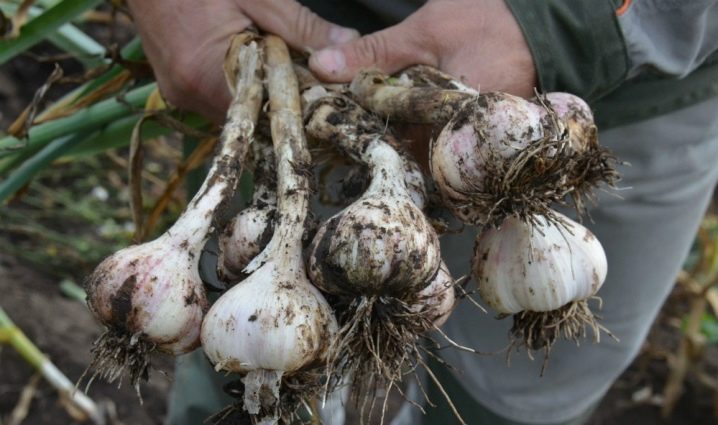
The remaining good harvest must be prepared for harvesting for winter storage. Natural drying is considered the most common. For this, the garlic is not cut off from the tops, since with its help it is necessary to weave it into special braids and hang it. To make the ligaments stronger, it is recommended to use nylon threads as fixators.
If you don't want to tie into braids, then the algorithm of actions after harvesting will be as follows: the heads are cleaned as carefully as possible from the ground, the roots and stems are cut off, leaving a margin of several centimeters on each side. If you cut directly near the head, then it can be damaged and, thus, start the process of decay.


There are several ways to dry pruned garlic. In order to determine the most suitable one, it is recommended that you familiarize yourself in more detail with each of them.
- Drying outside... This method is considered natural. In order to dry the crop, it is necessary to spread it out in the area where the sun's rays fall. Burlap or some other material is used as a lining. The disadvantage of this method is that it can only be carried out on sunny days. At the same time, you need to constantly monitor the harvest so that it does not accidentally get wet with rain.
- Home drying - carried out in a dark but ventilated room. The disadvantage of this method is duration. In time, the whole process takes 2 to 3 weeks.
- Electric drying is a modern way.... In order to implement it, you must first prepare the garlic. It is cleaned, washed in warm, but not hot water, cut into slices. They must be placed on baking sheets and placed in an electric dryer. When the chopped garlic is dry, it is stored in special containers.
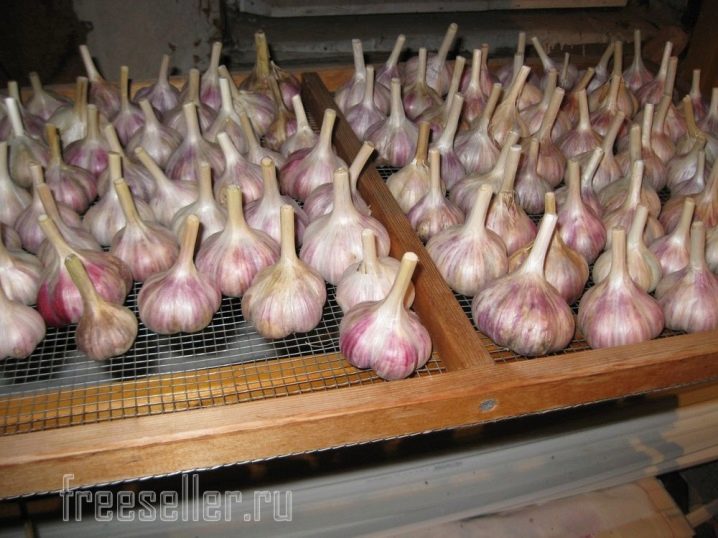
In order for spring garlic to survive as long as possible, you need to comply with the requirements. First of all, they relate to the temperature regime. The optimum temperature for storing spring garlic is from +16 to +20 degrees Celsius. At the same time, it is important not to allow sudden temperature changes, as this will start the decay process. If stored at a higher temperature, then garlic can also be spoiled: chopped into slices will become flabby, and whole garlic will give arrows.
Another equally important indicator is air humidity. It should not exceed 80%. If this figure rises to higher levels, the garlic will also start to rot. It is recommended to store the vegetable in dark places, as regular exposure to light will lead to diseases.
Garlic has a specific and very strong aroma, so it is not customary to store it next to other vegetables or some kind of food.
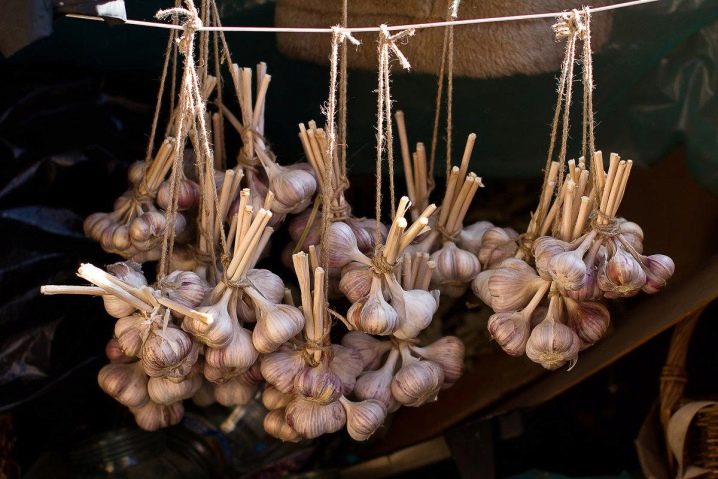
There are proven ways to store garlic. One of the traditional ones is storage in glass jars. To do this, it is divided into cloves, and placed in 3-liter jars, tightly closed with plastic lids.
The rustic way of storing garlic is in flour. To do this, take exactly the same glass jars, cover them with garlic cloves by about half, and then add flour. It is believed to be able to absorb excess moisture and prevent decay processes.


Some craftsmen prefer to store garlic in paraffin. Looking ahead, it should be said that the method is unconventional and requires some skill. The waxing process consists of several stages.
- You need to take a few large candles and melt them in a water bath.
- Take the garlic by the tail and dip it completely in paraffin. Hold over the container for a few seconds, waiting for the excess substance to drain.
- Then the garlic is laid out in rows on parchment paper.
The disadvantages of this method are the processing time.
Another proven storage method involves the use of salt. This method is identical in technique to storage in flour. The only difference is in the materials used. Some people also like to freeze the garlic. To do this, it must be peeled, washed, dried with a paper towel and placed in containers (plastic cups, special containers for freezing or plastic bags). You need to lay out in small portions so that in winter it is convenient to take it out and defrost it a little.
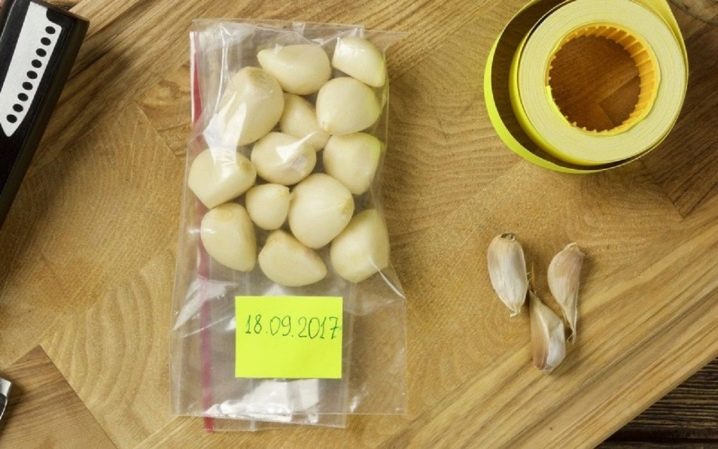













The comment was sent successfully.